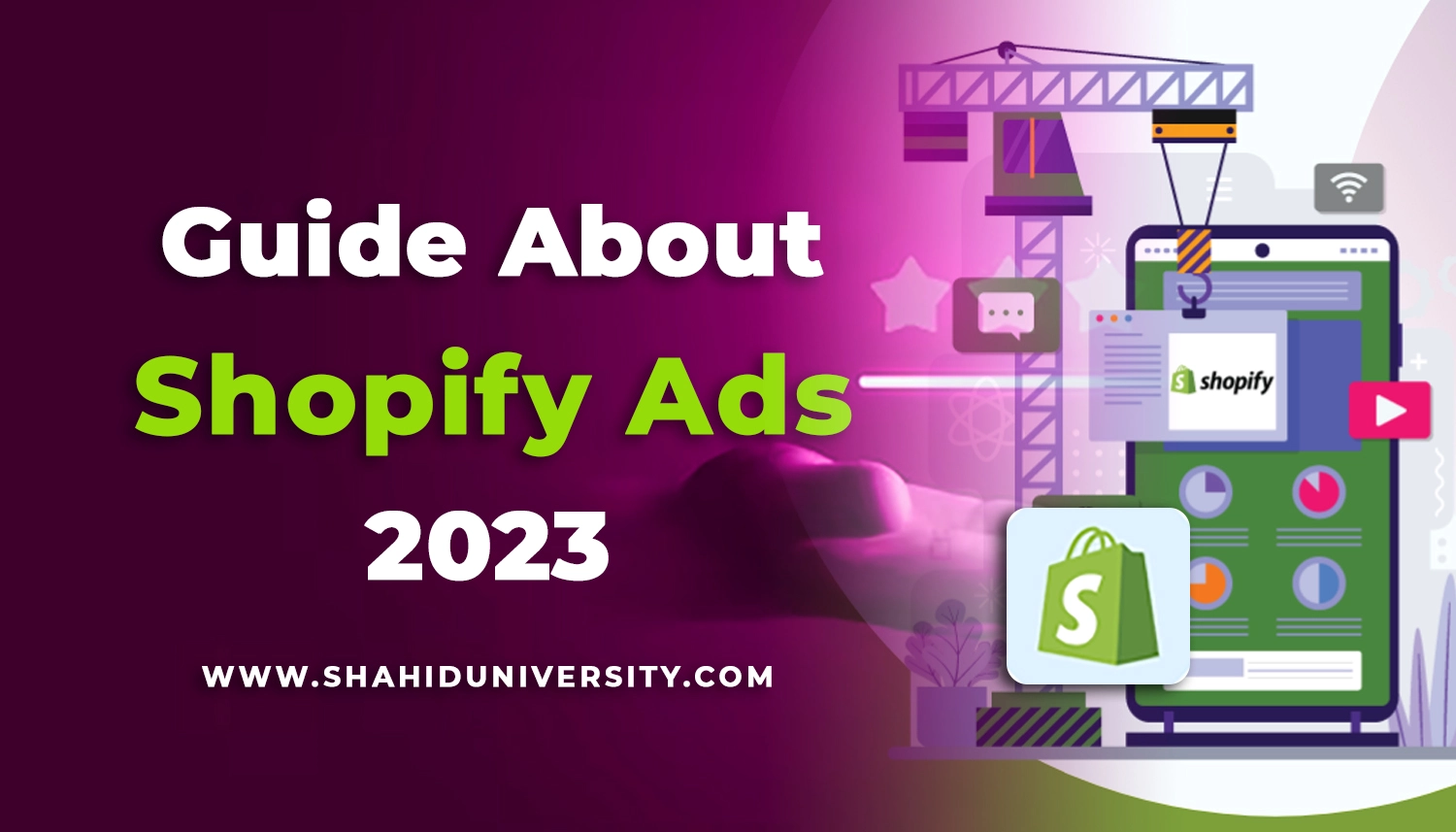Shopify has emerged as a highly favored choice among entrepreneurs and businesses in the e-commerce realm. With its user-friendly interface, adaptable features, and effortless compatibility with a variety of advertising tools, it stands out as a robust platform for individuals seeking to establish or grow their online stores.
If you’re curious about the functionality of Shopify Ads and how to make the most of them, you’ve come to the right spot. In this article, we will thoroughly explore the realm of Shopify Ads, encompassing fundamental concepts to advanced tactics.
Types of Shopify Ads
Shopify offers a diverse range of advertising options to cater to the varying needs of e-commerce businesses. The types of Shopify Ads include:
- Google Shopping Ads: These ads allow you to showcase your products on Google search results, making it easier for potential customers to find and purchase your items.
- Facebook Ads: With this type, you can promote your products on the world’s largest social media platform, targeting specific demographics and interests to reach your ideal audience.
- Dynamic Retargeting Ads: These ads re-engage visitors who have previously interacted with your website, displaying products they’ve shown interest in, thus increasing the likelihood of conversion.
- Instagram Ads: Leveraging the visual appeal of Instagram, these ads enable you to engage with a visually-driven audience and promote your products seamlessly.
- Pinterest Ads: If your target audience aligns with Pinterest users, these ads can showcase your products with visual content, helping you gain exposure among a creative and engaged community.
How Shopify Ads Work
Shopify Ads offer a flexible advertising solution for online businesses in the e-commerce industry. They operate by enabling users to craft and manage personalized advertising campaigns right from their Shopify dashboard. Users have the option to choose from a variety of ad types, including Google Shopping and Facebook ads, in order to target specific audiences across different platforms. To kickstart your advertising efforts, you’ll need an active Shopify store and a well-defined target audience.
It’s crucial to establish a budget to have control over your advertising expenses. Crafting effective Shopify Ads entails paying attention to design, creating persuasive ad copy, and incorporating high-quality visuals. Ongoing monitoring, A/B testing, and necessary adjustments are vital for optimization. To gauge the success of your campaigns, Shopify provides comprehensive analytics, which enable businesses to track important metrics and make well-informed decisions.
Setting Up Shopify Ads
Establishing Shopify Ads plays a crucial role in enhancing the online visibility of your e-commerce venture. To commence, set up a Shopify store if you haven’t done so already. Carefully select your products, ensuring they align with both market demand and your brand’s identity. Precisely define your target audience, as this step is vital for reaching the most relevant customers.
It’s imperative to establish a budget to maintain control over your advertising costs. These fundamental measures serve as the foundation of your Shopify Ads campaign, allowing you to effectively harness the capabilities of this potent platform to drive the growth of your business.
Creating a Shopify Store
Starting a Shopify store is the initial move in establishing a strong online presence. With its user-friendly tools and a seamless interface, setting up your store is a straightforward process. The first step is to carefully choose the right products that align with your brand’s identity and meet the needs of your target audience. It’s essential to define your target audience as this helps you tailor your marketing strategies effectively.
Setting a budget is important for maintaining control over your expenses. The design of your store, the wording in your advertisements, and the quality of your images and videos all play a significant role in capturing your audience’s attention. Creating an appealing and informative storefront is critical for attracting customers and launching your e-commerce journey.
Choosing the Right Products
Selecting the appropriate items for your Shopify Ads campaign is a crucial factor in guaranteeing its prosperity. Begin by conducting comprehensive market research to pinpoint products that are sought after and match your brand’s character. Take into account the preferences and requirements of your intended audience. The choice of products holds a substantial role in drawing potential clients and boosting conversions.
It is vital to provide products that not only connect with your target demographic but also distinguish themselves in a competitive marketplace. Whether you are introducing a fresh line of products or advertising existing ones, a considerate product selection can significantly impact the effectiveness of your Shopify Ads campaign.
Defining Your Target Audience
Identifying your target audience is a crucial element of any marketing strategy. This process entails comprehending the characteristics, passions, and actions of the individuals most likely to show interest in your products or services. By constructing a comprehensive profile of your ideal customer, you can customize your marketing endeavors to align with their requirements and preferences. This not only boosts the effectiveness of your campaigns but also elevates the overall customer experience.
Whether you’re a small business owner or a marketing expert, the capacity to precisely delineate your target audience is an invaluable skill. It guarantees that your messages reach the appropriate individuals, heightening the chances of conversion and long-term customer contentment.
Setting a Budget
Establishing a budget is a crucial initial task when commencing a Shopify Ads campaign. Your budget acts as a financial guide, directing your marketing endeavors. It’s vital to thoughtfully assess your available resources and financial objectives before distributing funds. Begin by evaluating your overarching marketing goals, the scope of your business, and the competitive landscape in your industry.
By defining a clear and practical budget, you ensure effective audience targeting without unnecessary expenditures. The adaptability of Shopify Ads allows you to modify your budget as needed, making it a dynamic tool for managing your advertising expenses. In the realm of e-commerce, setting a budget is the primary step towards achieving a successful and cost-efficient advertising campaign.
Creating Effective Shopify Ads
Creating effective Shopify advertisements is a complex process centered around grabbing your audience’s interest. It commences with the creation of visually striking ads that effectively showcase your products. These ads should be expertly designed, utilizing high-quality images and videos to make a lasting impression. Complementing these captivating visuals is the art of composing persuasive ad text.
Your language should connect with the audience, highlighting the advantages of your products and motivating them to take action. Striking a balance between visual appeal and compelling language is crucial. Furthermore, A/B testing plays a vital role in optimization. Consistently evaluate ad components such as headlines, images, and calls to action, and use data-driven insights to refine your advertisements. This approach allows you to generate Shopify ads that not only capture attention but also convert viewers into customers.
Designing Eye-Catching Advertisements
Creating eye-catching advertisements is a multifaceted art, blending creativity with strategy. The design of your ads plays a pivotal role in capturing your audience’s attention. To craft visually compelling advertisements, focus on the following key elements:
- Visual Appeal: Use high-quality images or graphics that resonate with your brand and product. Vibrant colors and captivating visuals can make your ad stand out.
- Simplicity: Keep the design clean and uncluttered. A cluttered ad can overwhelm viewers, causing them to lose interest.
- Relevance: Ensure that your visuals align with the message and purpose of your ad. The imagery should directly connect with the product or service you’re promoting.
- Typography: Choose fonts that are legible and complement the overall design. Use different font sizes to emphasize key points.
- Call to Action (CTA): Highlight your CTA with contrasting colors and make it prominent. The CTA should be clear and compelling, encouraging viewers to take action.
By carefully considering these elements, you can design advertisements that not only catch the eye but also leave a lasting impression on your audience.
Crafting Compelling Ad Copy
Creating captivating advertising text is a skill that can have a significant impact on the success of your advertising campaigns. It involves using persuasive language that seizes the reader’s attention and motivates them to take action. Your ad text should emphasize the advantages of your product or service, catering to the needs and desires of your target audience. To make it compelling, it’s crucial to keep it concise and clear in conveying your message.
Incorporate powerful, action-driven words like “discover,” “save,” or “get started” to encourage engagement. Craft a narrative or scenario that resonates with your audience, helping them envision how your offering can enhance their lives. Always emphasize your unique selling points and generate a sense of urgency to spur immediate action. Crafting persuasive ad copy is a fusion of creativity and psychology, strategically designed to captivate and convert.
Using High-Quality Images and Videos
Utilizing top-notch images and videos is crucial when crafting impactful advertisements. Visual content serves as a potent means of grabbing your audience’s attention and communicating the core qualities of your products or services. When your visual elements are crisp, clear, and expertly created, they not only enhance the visual appeal of your advertisements but also foster trust with potential customers.
High-quality visuals allow you to present your products comprehensively, showcasing them from various angles, thereby encouraging potential buyers to engage. They exude professionalism and a keen eye for detail, factors that can significantly influence the success of your advertising campaigns. It’s important to remember that in the realm of digital advertising, a single image can convey a wealth of information, and a well-crafted video can weave a compelling narrative.
Optimizing Shopify Ads
Enhancing the effectiveness of your e-commerce marketing efforts heavily relies on the optimization of your Shopify Ads. A/B testing emerges as a potent method that empowers you to fine-tune various ad elements, including headlines and visuals, all driven by data-driven insights. Consistently tracking your ad performance via Shopify’s integrated analytics tools offers crucial insights into key metrics such as click-through rates and conversion rates.
This analytical approach equips you with the knowledge needed to make informed adjustments to your ad campaigns, which might involve refining your target audience, updating your ad content, or optimizing your bidding strategy. Continuously refining your Shopify Ads ensures that you can maximize their impact, meet your advertising objectives, all while keeping your budget in check.
Monitoring Ad Performance
Evaluating the effectiveness of your advertising campaign is crucial for its success. This entails closely monitoring and examining important metrics to ensure that your advertisements are yielding the desired outcomes. Metrics such as click-through rates, conversion rates, and return on investment (ROI) serve as valuable indicators of how well your ads are performing.
Regularly assessing these metrics empowers you to make informed data-driven adjustments to enhance the effectiveness of your advertising campaigns. It’s vital to utilize the analytical tools provided by platforms like Shopify to keep track of how your ads are performing, helping you identify both strengths and weaknesses in your campaigns. By staying attentive and responsive to these insights, you can refine your advertising strategy and achieve better results.
Ad Campaign Adjustments
Ad Campaign Adjustments entail vital fine-tuning and modifications to advertising campaigns in order to enhance their effectiveness. In the ever-evolving realm of digital marketing, it is crucial to consistently monitor the performance of your ads. These modifications may encompass adjustments to the target audience, refining ad content, or changing bidding strategies.
By meticulously scrutinizing data and metrics, advertisers can make informed choices to enhance their campaigns and achieve superior outcomes. Ad Campaign Adjustments constitute an ongoing process that ensures your advertising endeavors stay in sync with your objectives and the preferences of your audience. Essentially, they aid you in adapting and evolving your strategies to accommodate shifts in market dynamics and consumer behavior, ultimately leading to more prosperous ad campaigns.
Shopify Ads vs. Other Advertising Platforms
In the continually growing realm of online commerce, choosing the correct advertising platform is vital for the prosperity of your web-based business. Shopify Ads, a prominent contender in the advertising space, provides numerous benefits. Nevertheless, to make a well-informed choice, it’s crucial to contrast Shopify Ads with other well-known advertising platforms such as Amazon Ads, eBay Advertising, and WooCommerce. Let’s delve into these comparisons and distinctions to assist you in identifying the platform that aligns with your particular requirements.
Shopify Ads
Pros:
- Seamless Integration: Shopify Ads integrate effortlessly with your Shopify store, streamlining the process of creating and managing your ad campaigns.
- User-Friendly: Shopify’s user interface is beginner-friendly, making it an excellent choice for those new to online advertising.
- Diverse Ad Types: Shopify offers a variety of ad types, such as Google Shopping Ads, Facebook Ads, and dynamic retargeting ads, allowing you to reach your audience on multiple platforms.
- Budget Control: You have control over your advertising budget, making it suitable for businesses of all sizes.
- Detailed Analytics: Shopify provides in-depth analytics tools to help you track the performance of your ads, enabling data-driven decisions for optimization.
Cons:
- Platform Dependency: Shopify Ads are primarily designed for Shopify stores, limiting their usability if you decide to change your e-commerce platform.
- Competition: As Shopify is popular, there may be increased competition for ad placements, potentially affecting ad costs.
Amazon Ads
Pros:
- Vast Customer Base: Amazon boasts a massive customer base, offering an extensive reach for your products.
- Keyword Targeting: With Amazon Ads, you can target customers based on specific keywords and product categories, allowing for precise ad placement.
- Amazon Prime: Access to Amazon Prime members, who tend to spend more, can be highly profitable.
Cons:
- Competitive Bidding: Advertising on Amazon can be costly due to competitive bidding, making it less budget-friendly for some businesses.
- Limited Off-Site Reach: Amazon Ads primarily focus on the Amazon platform, which limits exposure beyond the Amazon ecosystem.
eBay Advertising
Pros:
- Auction-Based System: eBay’s auction-style advertising can lead to cost-effective ad placements, as you only pay when your ad performs well.
- Diverse Ad Formats: eBay offers various ad formats, from promoted listings to banner ads, providing flexibility in your ad strategy.
- Access to eBay Shoppers: eBay Advertising allows you to reach eBay’s substantial user base.
Cons:
- Niche Audience: eBay’s audience may not be as diverse as other platforms, limiting your reach to a specific demographic.
- Limited to eBay: Like Amazon Ads, eBay Advertising primarily targets shoppers on the eBay platform.
Woo Commerce
Pros:
- Open Source: Woo Commerce is an open-source e-commerce platform, offering flexibility and customization options.
- Cost-Effective: Woo Commerce doesn’t charge transaction fees or impose limits on product listings, which can be budget-friendly for smaller businesses.
- WordPress Integration: If you have a WordPress website, Woo Commerce seamlessly integrates with it, making it an attractive choice.
Cons:
- Complex Setup: Setting up and managing Woo Commerce may require more technical expertise, potentially posing challenges for beginners.
- Limited Advertising Features: While Woo Commerce offers e-commerce capabilities, it lacks the comprehensive advertising features found in dedicated advertising platforms.
Conclusion
In conclusion, mastering the art of Shopify Ads can be a game-changer for your e-commerce business. These versatile advertising tools, integrated seamlessly with your Shopify store, open up a world of possibilities. From targeting the right audience to crafting compelling ad content, you have the power to shape your advertising strategy.
As you navigate through the vast realm of online advertising, remember to stay data-driven and adaptable. Continuously optimize your campaigns, learning from both your successes and challenges. With metrics at your disposal, you can gauge the effectiveness of your ads and make informed decisions.
Shopify Ads are not just an option; they are a pathway to success in the competitive e-commerce landscape. So, invest time and effort in understanding, creating, and refining your ad campaigns. The potential for growth and profitability is within your reach. Use this conclusion as a stepping stone to unlock the full potential of Shopify Ads.
Frequently Asked Questions (FAQs)
- What is the cost of running Shopify Ads?
The cost of running Shopify Ads varies depending on your budget and advertising goals. You have control over your spending, and you can start with a budget that suits your business.
- Can I use Shopify Ads for a new e-commerce store?
Yes, you can use Shopify Ads for both new and established e-commerce stores. It’s a flexible platform suitable for businesses of all sizes.
- How do I measure the success of my Shopify Ads campaigns?
You can measure the success of your campaigns using metrics like ROI, click-through rate, conversion rate, and more. Shopify provides analytics tools for this purpose.
- What are some common mistakes to avoid when running Shopify Ads?
Common mistakes include targeting the wrong audience, using low-quality ad content, and failing to monitor and adjust your campaigns. Avoid these by following best practices.
- Where can I get more information on Shopify Ads?
For more information and in-depth guidance on Shopify Ads, you can visit Shopify’s official website and access their comprehensive resources.








